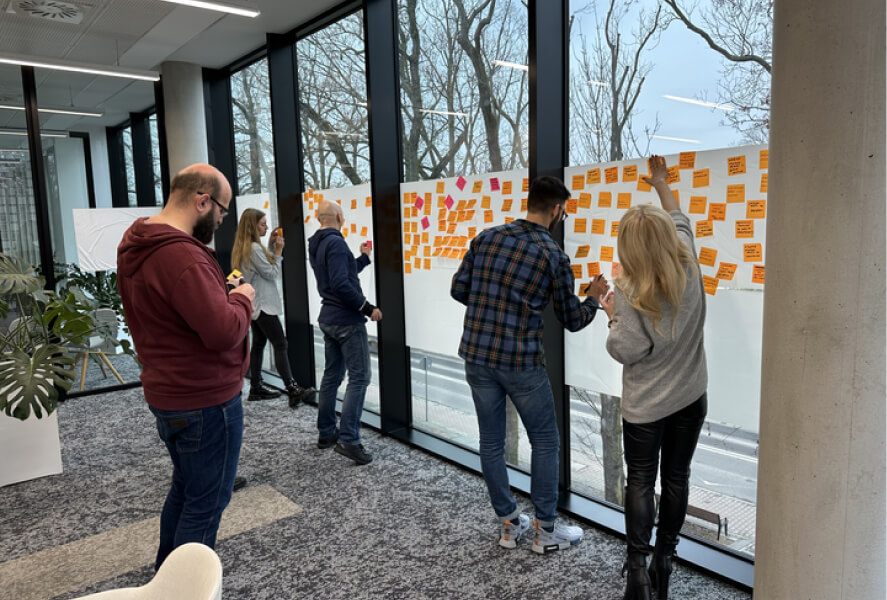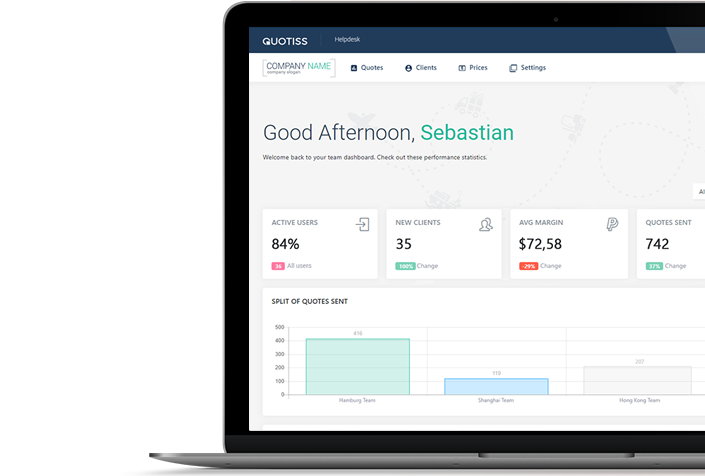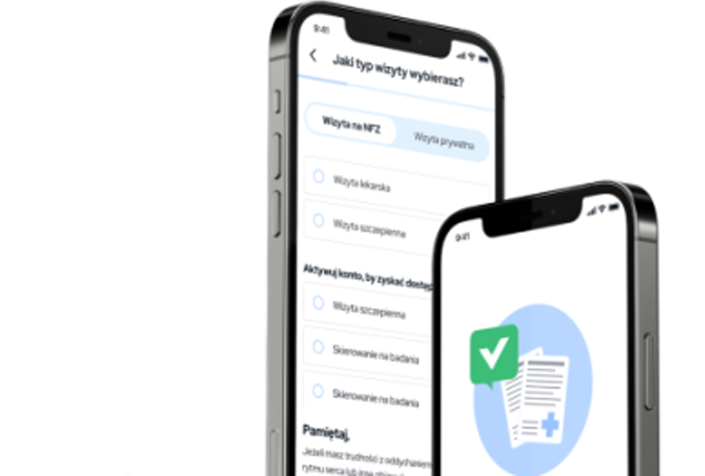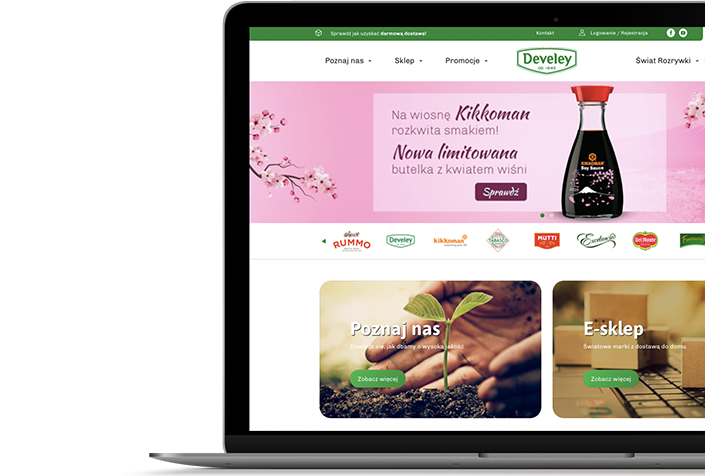Analytical workshop at Da Vinci Studio – step by step
We implement analytical workshops at Da Vinci Studio using the Event Storming method. This is an increasingly popular method of collaborative discovery and modeling of the processes by which software is developed. Our workshops contribute to more effective creation of the final product. They allow us to explore and understand the needs of end users and provide a better definition of project goals. As a result of this process, we get a consistent and transparent business model that serves as the basis for all software development activities.
What will you learn from this article?
- What is Event Storming and how does it work?
- Course of the workshop
- Work standards
- Tools
- What does the workshop at Da Vinci Studio look like?
- Why is it worth participating?
What is Event Storming and how does it work?
Event Storming (ES) was developed in 2012 by Alberto Brandolini as part of Domain-driven design (DDD). DDD is a way of designing software that focuses on understanding and mapping real-world problems and user needs to create more intuitive and efficient information systems. Since the inception of the concept itself, this workshop technique has gained a wide following related to domain-based design.
ES takes into account all stakeholders in a project. The most common are those representing technical and business teams.
On the Da Vinci Studio side, these are most often:
- Workshop facilitator – this person prepares the agenda, conducts the workshop and coordinates its progress.
- Project Manager – responsible for contacting the client, the logistics of the workshop and sending the finished materials to the client and arranging all the details with the client.
- Developer – supports the technical part of the meeting, creates technology recommendations and helps the team understand the functionality being developed.
- If necessary, other people may also be involved in the workshop, including, for example: UI/UX designer, analyst, or industry experts who will share their knowledge, detailed recommendations, and provide insight from a particular business field (e.g., TSL, medical, sports, or education).
On the client’s side, on the other hand – if possible – it is worthwhile to involve people from different fields and departments in the process to sound out the needs of each individual, for example:
- A person with domain knowledge, the so-called Product Owner (PO) who has knowledge of the product and is able to determine how it should be developed at the idea level.
- A technical person who is a kind of “liaison” between the PO and the contractor, in this case Da Vinci Studio. With such a person we talk about any issues and concerns during the programming work.
- A decision-maker (a person with business knowledge, usually at the management level).
However, if you do not have people with such competencies in your team, nothing lost. During the workshop we focus on the functionalities and business context of the solution being developed. We deliberately do not use technical vocabulary so that each participant understands the issues and problems raised during the meeting.
The analytical workshop at Da Vinci Studio enables free collaboration leading to the goal of functional and well-designed software. During the meeting, we want to learn about the business goals of the solution being developed in order to select the most effective technological options and present them to the client. To this end, we also discuss how the industry for which the product is being developed works.
Step by step
The workshop held at Da Vinci Studio is a business design method to create functional and well-designed software by understanding business processes. We can present the course of the workshop in 3 steps:
- Preparation – this stage takes place before the meeting. In it, we define the purpose of the workshop and select an appropriate group of people, including the facilitator (moderator). We also prepare the necessary materials to help implement the workshop.
- Meeting – during the workshop, participants, using cards, map the events and activities related to a given business process. This is gradually improved and developed during the workshop, until you have a final version that meets your expectations. It is important that during the meeting the group focuses strictly on the business process and not on the technological implementation, in order to get a functional and well thought-out solution.
- Implementation – after the workshop, the resulting business process model will be used to implement an information system or other industry-related solution.
How long does the workshop last?
It all depends on the complexity of the project and the topics we need to finalize before the start of development. The minimum workshop time at Da Vinci Studio is 4 hours, but most often the meetings last 6 hours. This is enough time to synchronize the participants’ knowledge, unify the vision, the process and identify problems that may arise in the process.
Work standards
As we mentioned, you don’t need much for the workshop, just a simple white board. Collaboration can also take place online in a tool created for this purpose (such as Miro). Example of an Event Storming session workshop at Miro:

source: https://miro.com/miroverse/event-storming/
As you can see from the example above, Event Storming is based on dissecting an entire process (e.g., how a mobile app for an online store works) using slips of paper in different colors. What are these colors and what do they mean?
Cards in Event Storming
In our workshops, we use cards in six colors, each with a different role. Most often we adopt the following matching:
- orange color – describing events occurring in the process (written in the past tense),
- light yellow color – the designation of the player (person) affected by the process,
- yellow color – notes, ideas,
- red color – i.e. hot spots, they contain questions, problems, unclear topics, risks, legal aspects (e.g. regulations)
- pink color – an indication of the use of an external system (such as an e-commerce payment gateway)
- green color – readable data (what the user must have in order to make a decision)
The use of sticky notes makes the work very easy and allows a clear presentation of all the important elements taking place in the solution.
Free IT consultation
A free consultation is a 30-minute call where you can consult on any topic related to the IT challenges your company is facing.
Let's talk!
Dominik Kaczmarczyk
New Business Manager
What is the workshop like at Da Vinci Studio?
-
- The first stage is brainstorming. Workshop participants add (place on the board) orange cards with all possible events in the process.
- The next step is to put the cards in order (questions may also arise at this stage, hence the important role of red cards). Here the facilitator plays a key role in helping the group choose the most appropriate way to organize the cards to provide the greatest value to the business. The cards should be organized on a timeline and/or organized into so-called event blocks, exactly as is done in the example above, where we have six such blocks:
– placing an order (order captured),
– shopping cart (shopping cart),
– offers (offers),
– order confirmation (checkout process),
– payment processing (payment processing),
– shipping of the order (order fulfillment). - After this stage of the workshop, we usually invite guests for a short break
- The next activity, after the break, is to assign players to individual processes. Then we move on to discuss the red cards – it is important to answer the questions asked and address the doubts that have arisen along the way.
- The next step is to prioritize the problems that need to be solved. At this stage it is important to find answers to such questions as:
– what responses will be required for an event to occur?
– what must happen for an event to occur? - The penultimate stage of each workshop is to discuss the system/technology solutions needed to make the system work properly and as expected.
Finally, our facilitator summarizes the workshop and informs about the next steps, so that the full picture of the progress of the work was clear to each party. At this stage we also confirm the type of post-workshop materials. These materials vary each time depending on the needs, and we agree on their scope before signing the contract, so that the client has a sense of security and full knowledge of what we will deliver after the meeting and in which direction it will proceed.
After the workshop session, the Da Vinci Studio team analyzes the information gathered during the meeting, determines the next steps to be taken in the project, prices the work, and creates the aforementioned post-workshop materials, which are delivered to the client on the agreed date.
Why participate in the workshop?

There are at least four important reasons to use Event Storming when working on a new IT product:
- Facilitated communication – extensive company structures and numerous internal processes often cause difficulties in communication between the various teams involved in working on a given project. Working with the Event Storming methodology allows you to find out how the various processes work and how the different parts of the chain affect each other. Gathering everyone involved in a project in one place provokes discussion and allows multiple perspectives and opinions to be heard and confronted.
- Effective problem solving – ES uses what is known as reverse storytelling, or telling the process from the end. This makes it possible to detect potential shortcomings or risks. Our workshops provide a space to discuss problems from different perspectives and reveal gaps in knowledge or conflicting positions, thus eliminating or minimizing risks associated with a project.
- Consistent terminology – often imprecise nomenclature is a source of many misunderstandings. The workshops we conduct at Da Vinci Studio standardize communication and the terminology used, which eliminates the risk of using different terms to describe the same thing. As a result, you gain confidence that each team member is properly understood.
- Simplicity – this is probably the biggest advantage of our workshops. We break down complex processes into easily digestible elements and use understandable terminology. This ensures that all participants are able to understand what is happening during the meeting and how the project will be implemented.
Summary
Event Storming methodology is an effective tool used by our Software House in working on projects for our clients. By attending the workshop, you will have the opportunity to improve your idea (or develop an existing product), and discuss it with an experienced IT team who will provide valuable recommendations on functionality and technology. After the workshop, our team will be able to accurately determine the cost of completing the project according to your preferences, tailor the functionalities to your needs and ensure compliance with industry best practices.

















